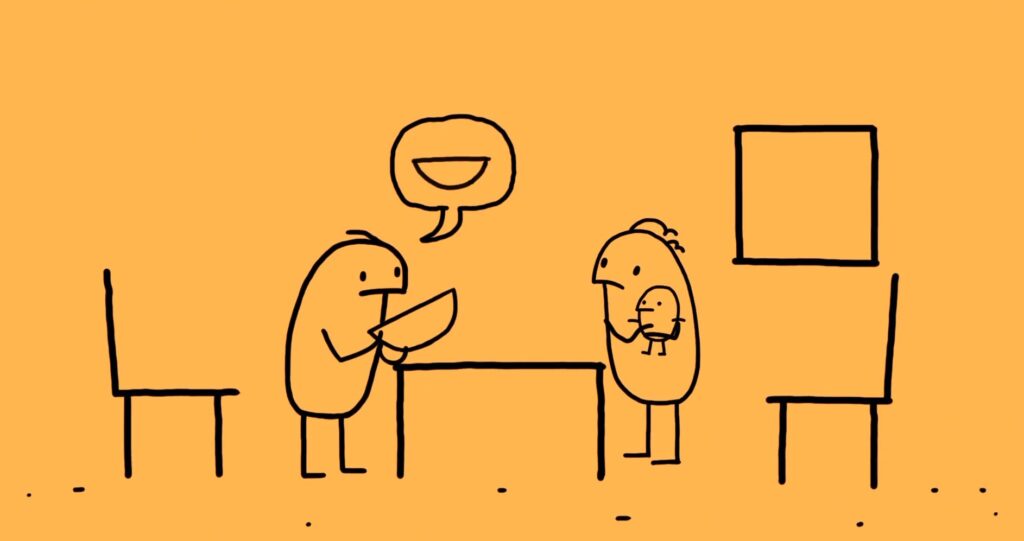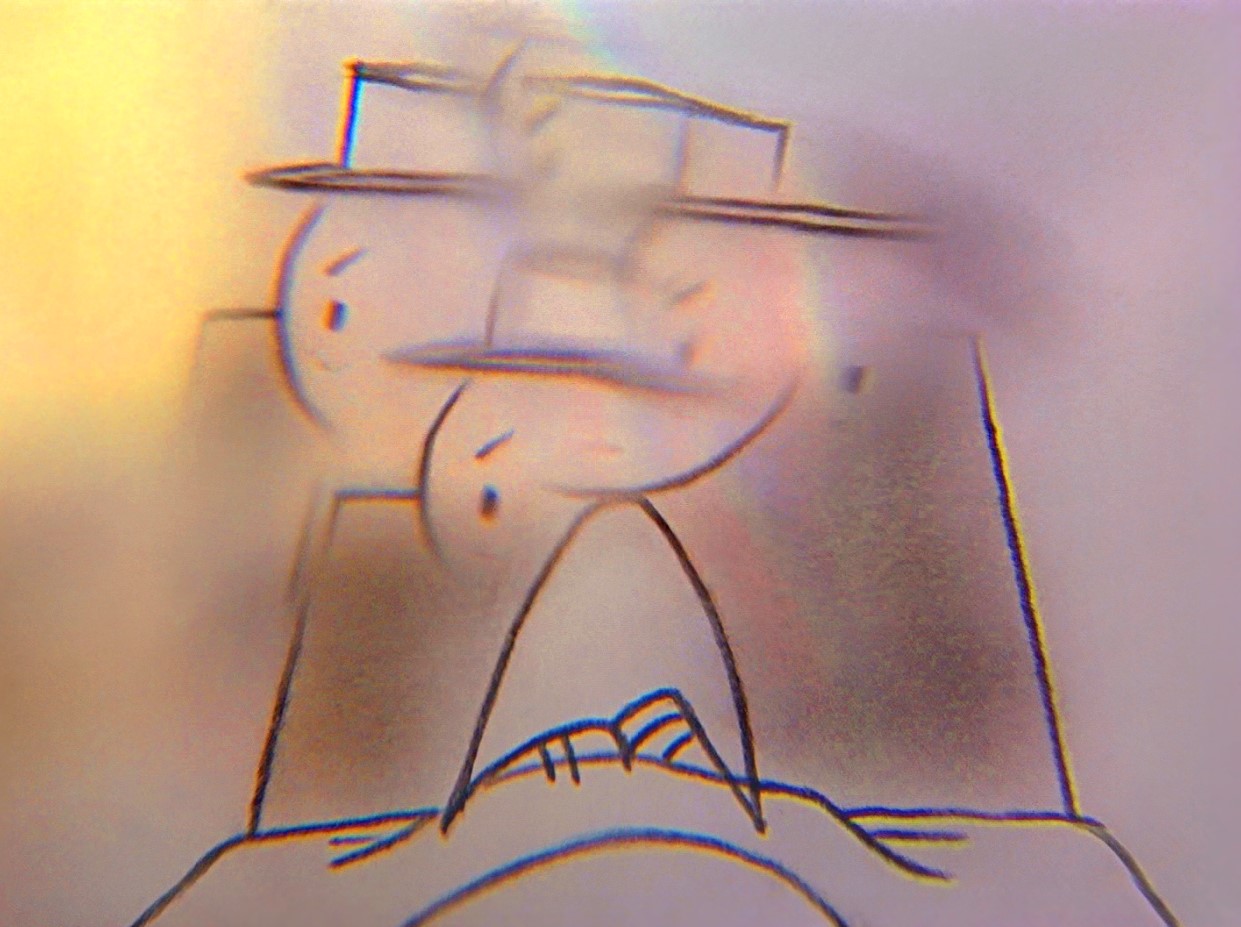| J.R Jones |

It’s Such A Beautiful Day + Me play at the Trylon Cinema Friday, November 8th, through Sunday, November 10th. Visit trylon.org for tickets and more information.
Don Hertzfeldt’s characters have always struggled for words. In the opening scene of his hourlong animation It’s Such a Beautiful Day (2012), the everyman protagonist, Bill, recognizes someone walking toward him on the street and prepares a greeting. But when they pass, Bill mixes up “How’s it going?” and “What’s up?” to blurt, “How’s up?” Pivoting, the other person replies, “Thanks!,” and Bill, now flummoxed, calls out, “Weh!”
It’s an awkward moment in a filmography that abounds in them. So many of Hertzfeldt’s characters are locked inside their subjective experience, longing to make contact with others but lacking the courage or articulation to connect. Words are inadequate to the task. In a sense, this same battle to communicate verbally has played out in Hertzfeldt’s work. For 30 years now the veteran DIY animator has experimented with different strategies for articulating his increasingly cerebral, philosophical and otherworldly visions. Yet the gap between word and image in his films has steadily widened—to the breaking point.
Raised in middle-class Fremont, Calif., Hertzfeldt took to animation as a high school student with a VHS camera, and while earning a B.A. in film from the University of California, Santa Barbara, he created a pair of hand-drawn 16-millimeter cartoons, Ah, L’Amour (1995) and Genre (1996), whose wiggly energy and gory sight gags made them instant favorites on the festival circuit. He stuck with hand-drawn animation in college because it was less expensive to produce than live action, yet the personal time commitment was extraordinary. His third student film, the 11-minute Lily and Jim (1997), required him to execute some 10,000 drawings.
A conscious leap forward from shock humor to dialogue-driven narrative, Lily and Jim probes the limits of conversation, alternating between the title characters as they give competing accounts of a blind date. Lily and Jim labor to find a point of connection over dinner, their chit-chat an excruciating concerto of dead-end topics and uncomfortable pauses. “Say something sexy,” Lily tells herself in a thought balloon. “Something witty, yet alluring,” thinks Jim. He asks, “Are your parents from around here?” Lily replies, “No. My parents were incinerated when I was three.” The characters are simply inked against a white screen, yet their lips are meticulously animated to enunciate every word—an ironic exercise for a film about speech falling short.
Hertzfeldt retreated from language for his senior-year film, Billy’s Balloon (1998), and the result was a giant creative advance. Completely wordless, the short wickedly parodies the classic children’s fantasy The Red Balloon with expertly timed slapstick—in this update the magical balloon mercilessly beats its young owner about the head, then pulls him high into the sky and drops him, again and again. Billy’s Balloon won Hertzfeldt the Grand Prix for best animated short at the Cannes film festival. His next short, the Oscar-nominated Rejected (2000), was a furiously creative satire of advertising that used on-screen intertitles and Beethoven’s Ninth Symphony to introduce a series of deranged TV commercials.
As Hertzfeldt made a name for himself, media profiles often noted the monkish isolation of his craft. He worked alone every night, from dinner till dawn, in his Santa Barbara apartment. After graduating, he bought an old-fashioned 35-millimeter camera stand and rostrum (rumored to have been used on the classic Peanuts TV specials of the 1960s) that allowed him to do trick photography, compositing of different shots, and multiple irises opening and closing inside the film frame. The acquisition opened up a new chapter in Hertzfeldt’s creative life, yet it also dragged his filmmaking into a series of hallucinatory journeys on which words often trailed behind.

Nearly four years in the making, The Meaning of Life (2005) traces life on earth in 12 minutes, from the primordial ooze to humanity’s rise and fall to a distant future populated by bizarre creatures. In this context, human language is an evolutionary blip. The central sequence shows a growing assortment of stick-figure characters as they march left and right along a horizon, repeating the same banal remarks (“Give me your money!” “We know what’s good for you!”). As the characters multiply, so do the voices (“I don’t want it!” “Stop following me!”) No less than 56 actors contributed to the sequence; as the figures multiply and the voices pile up, words blur into cacophony. When a nuclear blast wipes out the entire race, the silence is a balm.
With It’s Such a Beautiful Day, screening this week at the Trylon, Hertzfeldt returned to verbal storytelling, casting himself as the omniscient narrator, and his unpracticed delivery brings to the film an empathy that was completely new to his work. The film’s three chapters (released as shorts in 2006, 2008 and 2011) follow the hero, Bill, through a series of neurological challenges that launch him into episodes of metaphysical questioning and psychedelic revery, irises opening inside a black frame to reveal live-action photography or little animated tableaux.
The storytelling integrates words and imagery better than anything else Hertzfeldt has done, yet his characters face the same old problems in connecting. Bill is especially isolated by his medical condition, slipping off into horrifying nightmares before being snapped back into reality. People can break through to each other with words: In a moment too tender for Hertzfeldt’s youthful gorefests, Bill is moved to find “I love you” written in the sand at a playground. He remembers the notes his mother used to pack with his school lunches to tell him, “I am so proud of you.” After she dies, he goes through her papers and learned how carefully she practiced her calligraphy for the notes. But Bill is a man whose eloquence settles at the level of “How’s up?” Near death, he tries to sum up a lifetime of wisdom for those at his bedside, but all he can come up with is “It smells like dust, and moonlight.”
After It’s Such a Beautiful Day, Hertzfeldt decided to get with the 21st century and used Photoshop and Final Cut software to create his next trio of films, released in 2015, 2017 and 2020 and gathered under the title World of Tomorrow. His characters are the same cartoonish figures, but the digital technology allows him to work with bold sheets of color and columns of type as he spins a futuristic story heavily influenced by Steven Spielberg’s A.I. Artificial Intelligence (2001). In the first installment, World of Tomorrow (also nominated for an Oscar), a rambunctious 4-year-old named Emily receives a visitor from 227 years in the future; this is her own clone, Emily 3, an adult woman two generations removed from “Emily Prime” but equipped with her original consciousness.
To create the soundtrack, Hertzfeldt visited his little niece in Scotland and recorded their conversations as they drew pictures together, then wrote his screenplay around her random remarks and cast a friend, animator Julia Potts, as the adult clone. World of Tomorrow was his first dialogue film since Lily and Jim nearly 20 years earlier, but this time the interaction is more complex, driven by the friction between Emily Prime’s exuberant babble and Emily 3’s starchy, unemotional exposition. What we’re hearing isn’t really a conversation so much as a contest between a child’s intuition and an adult’s intellect. When Emily 3 informs the girl that the cloning technology promises her immortality, the girl’s reply is “I had lunch today!”

This charming interplay elevates the first episode, but Emily Prime is a year older and wiser in World of Tomorrow: The Burden of Other People’s Thoughts and absent entirely from World of Tomorrow: The Absent Destinations of David Prime. In each of these, Hertzfeldt repeats the first episode’s pattern of time-travel visitation and endless lecturing, though by the end of David Prime (whose title character is mute), the narration grows so dense that I could hardly digest it. I prefer to watch it with the sound turned down, the better to enjoy its rugged planetary landscapes and dazzling star systems.
Sensing a problem, perhaps, Hertzfeldt steps back from the human voice again in his latest short, just as he did after the static, talky Lily and Jim. ME, which premieres in Minneapolis at the Trylon this weekend, transpires without a word, though the characters emit dialogue balloons containing question marks, exclamation points and emojis. Unlike the futuristic World of Tomorrow, ME unfolds in the present-day amid a pandemic dystopia of social isolation and rampant self-regard. Hertzfeldt has called it a film about narcissism and pain, but it also ruminates on the malign power of the internet and the difference between being part of a network and being part of a community.
ME opens with a driving percussion number and a line-drawn city landscape, the frame bisected horizontally by a line of fizzing telephone poles that become the film’s most familiar visual motif. The inventor hero sees his wife washing their baby in a bowl and carries the bowl shape around in a thought balloon. When his wife comes home the next day, she finds him building an electrical contraption with the bowl. From his home, the inventor drags a giant, black cable down a city street, ignoring the police brutality all around him, and attaches it to a remote communications station. Back home, the bowl becomes a helmet wired to the contraption, which the inventor dons; his device lights up, enchanting him with a blurred but colorful vision of himself.
Hertzfeldt created ME in the wake of the COVID-19 lockdowns, and it incorporates some of that ghastly year’s suffering and death. When the hero wins an award for his invention, he carries it home down a street littered with corpses, and he himself winds up getting tossed into a mass grave. Before long, black cables connect a network of users, covering the city streets and hanging from the sides of skyscrapers like spaghetti; people sit in the contraptions, mesmerized. Interpersonal conflict builds, and neighboring contraptions begin to charge and crash into each other, their occupants burned to a crisp. Before long, everyone on earth is dead.
I found ME the most difficult to follow of all Hertzfeldt’s films: key transitions happen in the blink of an eye, and without narration one can easily confuse the minimally drawn characters. Yet the film succeeds on the strength of its Kubrickian disdain and kaleidoscopic imagery, especially in its final sequence. After humankind has died off, Hertzfeldt introduces a woman—nothing but a brain, eyeballs, and a body of dangling, red and blue nerves—falling gently through outer space and channeling soprano Joan Sutherland as she sings “I Dreamt I Dwelt in Marble Halls,” an aria of lost love from The Bohemian Girl. Her Medusa-like hair is a flickering web of black wires, over which Hertzfeldt superimposes portraits of everyday people. Like the star baby at the end of 2001: A Space Odyssey, the woman is an open-ended metaphor, demanding contemplation and denying us the comfort of a conclusion.
I could try to describe all this better, but it’s too haunting for words.
Edited by Olga Tchepikova-Treon
